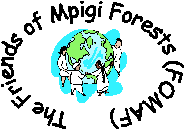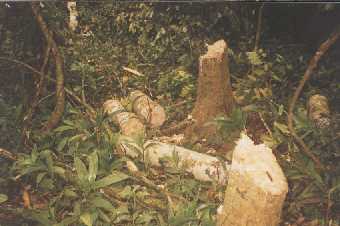|
Community Based
Ecotourism: What can the people of East Africa learn from Success
stories elsewhere?
By Kunga Ngece, East African Ecotourism Development
and Conservation Consultants, Nairobi, November 2002.
Abstract.
This paper
focuses on identifying ways in which Ecotourism could be used to
meet the demands for species conservation locally while economically
benefiting those practicing it. It looks at how Community Based
Ecotourism Enterprises could deliver local people from dependence to
independence, and how threatened species could be spared through
involvement o villagers in nature related businesses.
Introduction.
Ecotourism has been defined as environmentally
responsible travel and visitation to natural areas to enjoy and
appreciate nature that promotes conservation of the environment and
sustains the well being of a local people. Community-based
Ecotourism is where local people have substantial control and
involvement in an Ecotourism project and majority if not all
benefits remain in the community. Community-based Ecotourism has
characteristics such as; providing alternative income and employment
for local communities, increasing local and visitor awareness to
conservation, containing education and interpretation as part of the
tourist offer, and as well minimizing negative impacts on the
natural and socio-cultural environment. It should also support the
protection of natural areas by generating economic benefits for the
community, be organized for small groups and involve not only nature
but also indigenous cultures. Community-based Ecotourism should also
promote local species conservation.
For CBE to be successful, it must promote sustainable
development by establishing a durable productive base that allows
local inhabitants to enjoy in cash or kind. The social dimensions of
environmental conservation and development should be highly
considered. Research has shown that if rural communities are given a
chance to access of resources, they are more likely than other
groups to engage in direct actions to protect or improve the
environment. Environmental conservation among the rural folks is
however impossible if the virtue of job creation or benefits to them
is not considered. This could be inform of improved incomes,
improved facilities (communal or personal), better nutrition and
more reasonably better living standards. Further research has also
shown that a community that gets most of their resources from the
environment near them tend to be more responsive to the source of
the resource. Its on this scope that CBE is going a long way in
species conservation and economic empowerment in various parts of
the world, that need to be embraced in East Africa to check the high
rate of environmental degradation and promote sustainable
development.
CBE, family
finance and community projects; the case of indigenous Maya and
Garifuna people in Belize.
The Maya and
Garifuna communities of Toledo district in Belize, Central America,
through the Toledo Ecotourism Association (TEA) have a big story on
how a community can be organized. In 1990, TEA constructed a
guesthouse in each of the11 villages it operates. Every Village
Guest House had two rooms, one for men and another for women, with
separate bathrooms and toilets. Each house had a capacity of around
10 people. To ensure many of the villagers participated in the
project, they devised the food providers, where families agreed to
provide meals to guests staying in the houses. A rotating list for
breakfast, lunch and dinner was made so that no family could provide
a meal more than another. During meal time a young girl or boy goes
to the village guesthouse to take the visitors to their home for a
hot meal. Rotation enables many of the community members have the
opportunity to provide meals. Each family is paid directly by the
visiting guest. The family keeps 80% and 20% deposited to the
Community Fund. Villagers who choose not to participate benefit from
the community fund, whose money has been used for projects allied to
healthcare and schools. In the process the entire community has
benefited and in turn assist in environmental conservation.
CBE and ecology
among the Batu Putih community in Malaysia.
The
village of Batu Putih in Sabah, Malaysia, had for long experienced
tremendous loss of biodiversity due to logging and expansion of oil
plantations. Through support from WWF-Malaysia and WWF-Norway, the
Model Ecologically Sustainable Community Tourism Project (MESCOT)
was established. The model involved villagers in Ecotourism
therefore spreading benefits and awareness of conservation issues.
The project expanded through separate associations affiliated to it,
boat services and village handicrafts. The concept of home stay
accommodation was introduced, where visitors could stay in
villager’s homes at a fee. MESCOT developed interpretive trails
within the villages, raising interest and awareness among the
community. Participation in tourism by the villagers has enabled
clearance of rubbish local landscape improvements and a forest
rehabilitation programme, which has born tremendous fruits.
Discussion.
Both the Belize and Malaysia cases provide living
examples of how East Africans could also benefit local people while
conserving biodiversity. In East Africa, most areas with reasonable
nature and cultural resources are located in rural locality. Only a
handful of touristic destinations are near towns or cities.
Developing CBE in such areas can have reasonable impact to the local
people. CBE creates jobs for local people since most of the projects
are sensitive to local peoples concerns for them to obtain community
support. Examples include the Grampians National Park in Victoria
where attitudes by the community changed from negative to positive
after economic impacts for the local community developed over a
period of time. This has enabled success in conservation efforts by
the national parks service.
In East Africa, people and tourism have not been
compatible. In the Ngorongoro Conservation Area in Tanzania, the
policy of encouraging local involvement and cooperation in
conservation has not been effective. In Kenya the Mau Forest
Complex, long under management of the Ogiek, an indigenous community
has been undergoing many problems of degradation. This forest has a
big Ecotourism potential yet not utilized. Many such natural
resources exist in East Africa, most of which have not been utilized
by communities, but many of which are now under management of
private enterprises without regard for local benefits from these
resources. This has resulted to the locals viewing such investments
as suspect; therefore the local people have refused to be involved
in resource conservation. The locals feel they do not benefit in any
way, yet in some cases denial of use of such resources has been
evident. People feel cheated by not being able to utilize their own
resource. As a result CBE and conservation has not been able to grow
in East Africa and communities living around the resources still
remain impoverished. Use of protected resources by local people has
therefore become a first-hand affair, mainly illegally and without
control, causing degradation of resources, sometimes to
un-rehabilitable levels.
How can we
involve communities in Ecotourism and conservation?
Involving the
community in Ecotourism development is a very important aspect of
ensuring success of CBE. An avenue that many could take advantage of
is utilizing existing social and community structures. Use of local
opinion leaders, potential leaders and people with drive. Gender
should also be considered when designing any CBE enterprise.
It is also important that an understanding and
strengthening of legal rights and responsibilities of the community
over land, resources and development. Management and decision making
of CBE enterprises by the community also aught to be seriously
considered. Sustainability of the enterprise is also an issue that
should not be forgotten.
Conclusion
CBE if well established can play a reasonable role in
community development and bringing people closer to conservation. If
all the virtues of CBE are utilized, and local people participate
effectively in its development, species will be saved from
extinction for some of the rare and endangered organisms exist
within local reserves and communal lands. Local sustainable
development due to benefits from CBE would ensure all people
supported conservation o resources. CBE could be one of the ways in
which the people of East Africa could utilize to check the rapid
disappearance of important flora and fauna.
Reference
Denman, R. 2001. Guidelines for Community Based
Ecotourism Development. WWF International.
Sproule, K. 1996. Community Based Ecotourism
Development: Identifying Partners in the Process. The Ecotourism
Equation: Measuring the Impacts. Bulletin Series Yale School of
Forestry and Environmental Studies, Number 99. New Haven CT: Yale
University.
Wescott, G. 1995. Victoria’s National Park
System: Can the Transition from Quantity of Parks to Quality of
Management be Successful? Australian Journal of Environmental
Management. 4 (2):210-223
Development of this paper was facilitated by the East
African Ecotourism Development and Conservation Consultants, a
Kenya-based tourism, conservation and development consultancy in the
field of Ecotourism, community forestry and conservation, tourism
research, planning, development and sustainable development.
Comments on this article could be mailed to the author, email kagoka@avu.org,
PO Box 2044, GPO, Nairobi.
FOMAF
SECRETARIAT. C/O VSO UGANDA. PO BOX 2831. KAMPALA. UGANDA.
TEL
256 (0) 77 580935/ FAX 256 (0) 41 510090.
Copyright 2003, Friends of Mpigi Forests
Conservation and Development Organization. All rights reserved.
|

